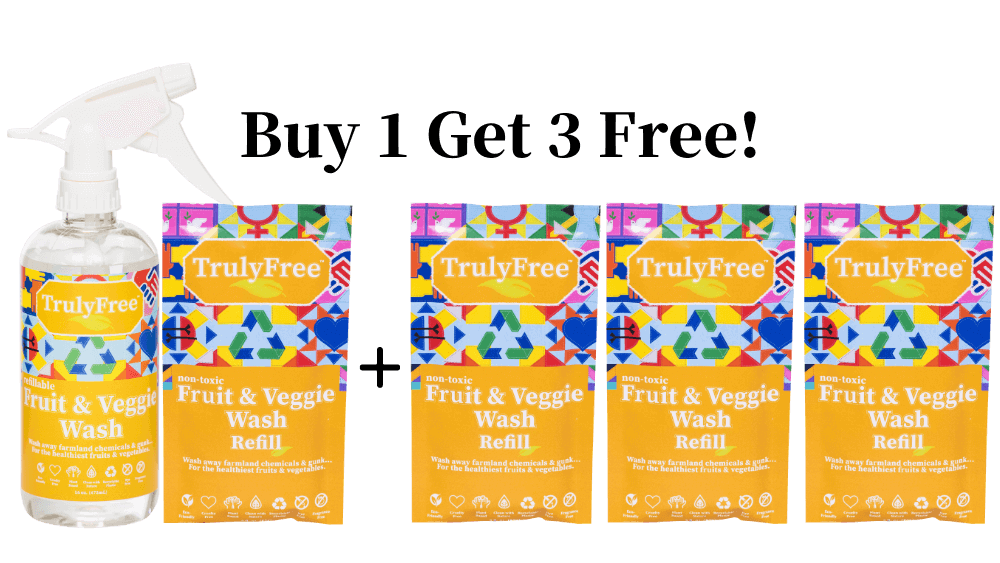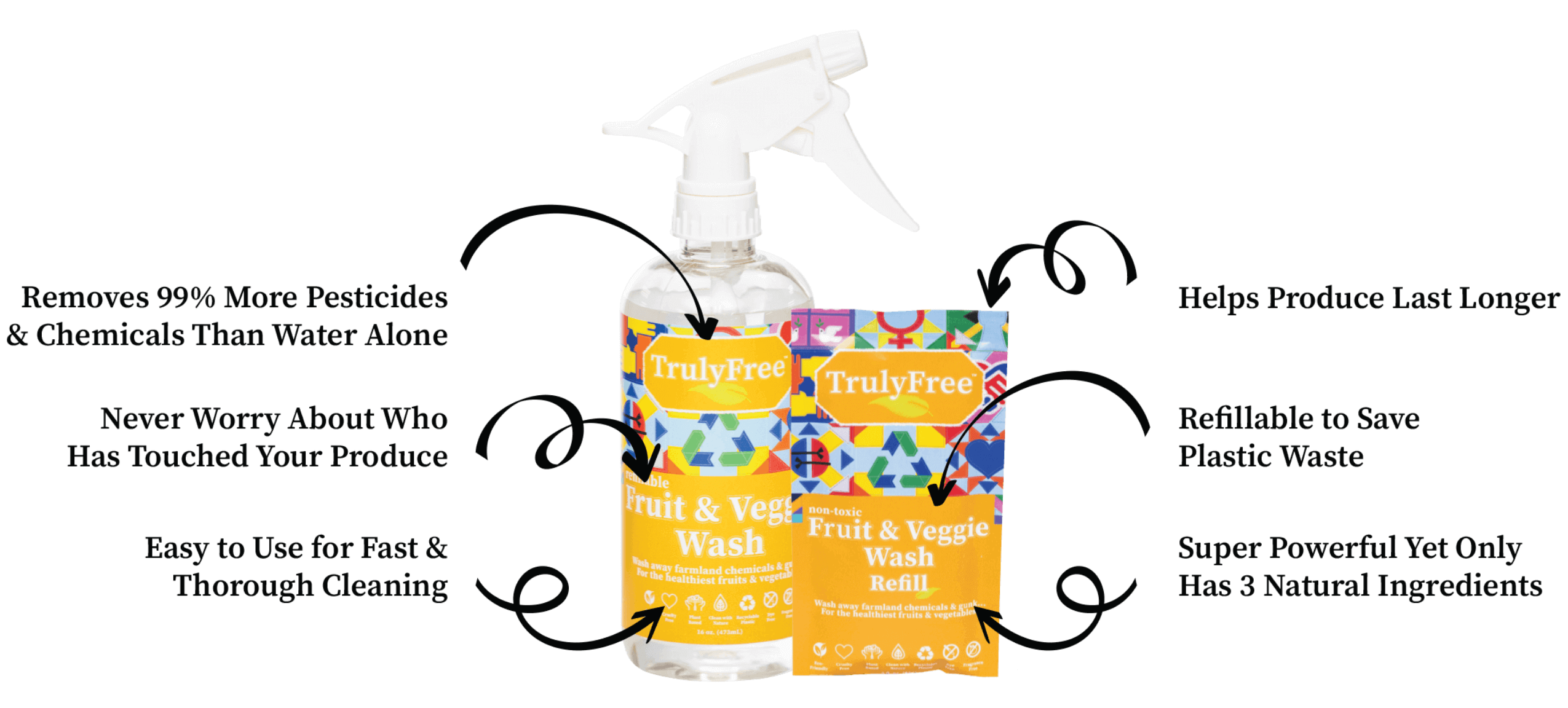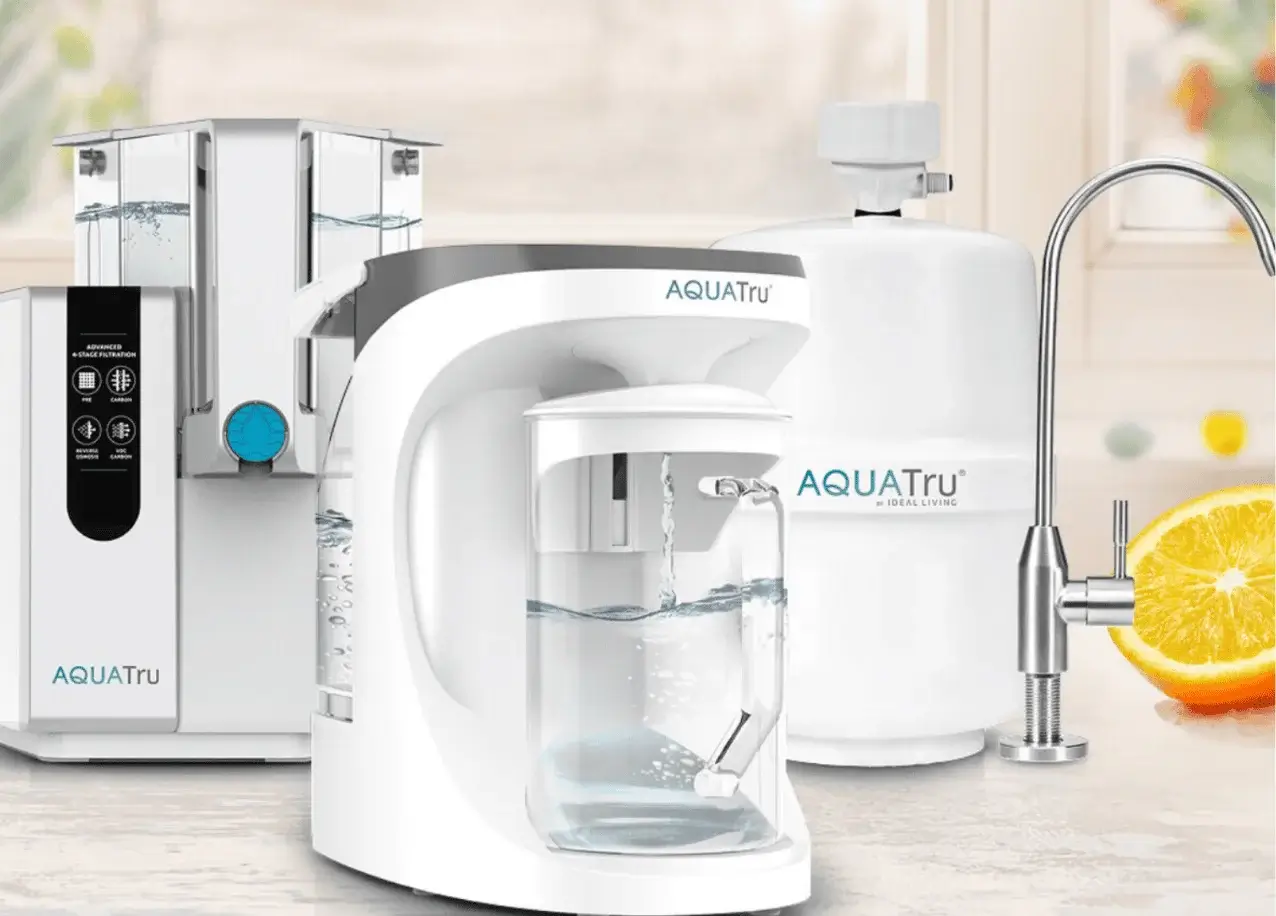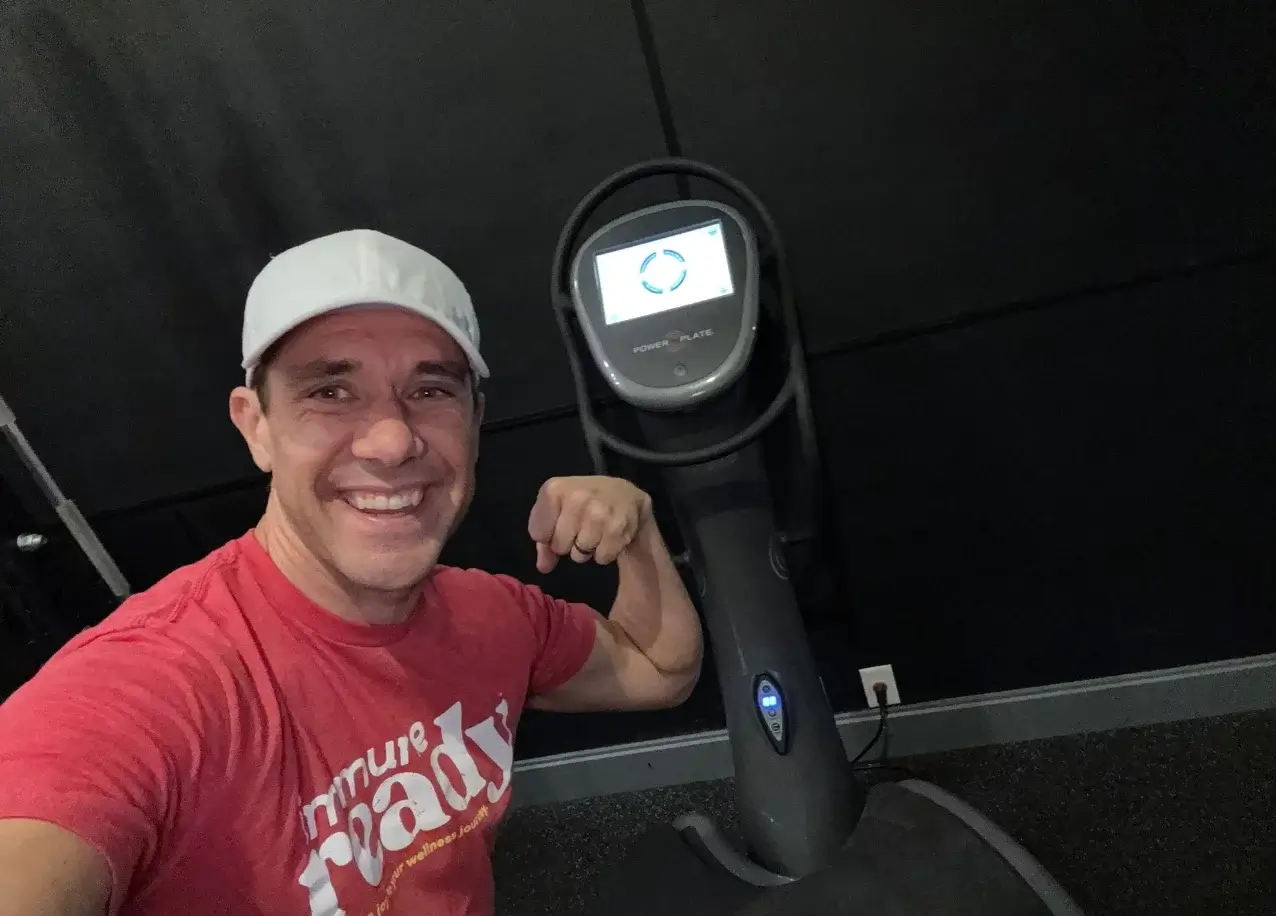Each year, millions of people get sick because of food contamination and a good portion of that is from produce! That’s why using the best fruit and veggie wash to clean all your produce is simply a must. Learn about our new favorite produce wash which is safer than bleach, and more effective than vinegar.
Table of Contents
Why We Need More Produce
When was the last time you ate a meal that was primarily plant-based? We’re talking more than just two hesitant bites of broccoli or that wedge salad smothered in blue cheese dressing. When we researched for The Essential Oils Diet we were appalled at how little produce most people eat.
We learned that about 90% of all Americans simply aren’t eating enough fruits and vegetables. According to the Institute for Functional Medicine, we all need to aim for around 5-7 servings per day of non-starchy and leafy green vegetables. We should also be aiming for a colorful diet, with lots of variety when it comes to those vegetables. But most people aren’t getting that.
It can be easy to say 5-7 servings, but you may be wondering what exactly constitutes a serving:
- For non-starchy vegetables that would be 1/2 cup either raw, steamed, or cooked.
- Non-starchy vegetables include things like asparagus, broccoli, carrots, cabbage, eggplant, mushrooms, onions, etc.
- For leafy green vegetables, a serving is equal to one cup of raw greens. That means if you’re planning on cooking them you’ll need to measure them first. The leafy green category includes vegetables such as bok choy, cabbage, dandelion greens, kale, and turnip greens.
It’s important for you to eat more vegetables in order to have a healthy diet. The Center for Disease Control’s Division of Nutrition, Physical Activity and Obesity has noted in studies that American’s aren’t getting the recommended amounts. This is in spite of the fact that the evidence clearly shows a positive correlation between increased vegetable consumption and a reduced risk for chronic health conditions such as diabetes, cardiovascular disease, cancer, obesity, and even premature mortality. The CDC further notes that “Seven of the top 10 leading causes of death in the United States are from chronic diseases. Eating a diet rich in fruits and vegetables daily can help reduce the risk of many leading causes of illness and death.”
Fresh fruit and vegetables can also be one of your best sources of vitamins, minerals, antioxidants, and fiber. The fiber makes them a good choice for proper digestion while all those micronutrients can help support your immune system.
Our research about the vital importance of bioactive foods highlights why everyone in our Natural Living Family should be eating more of them. Science even says that eating more fresh fruits and veggies can help you become more attractive – boosting energy and smoothing complexions. Pass the veggies, please!
Easy Ways to Eat More Fruits & Veggies
If you’re like most people chances are your vegetable consumption falls somewhere in the 2-ish cups per day range. With all the health benefits that vegetables can provide it makes sense to want to add more of them to your diet. If you’re not used to eating a large number of vegetables it can be challenging to figure out how to increase from the amount you are eating to the recommended 5-7 servings per day.
Remember this amount is specifically for non-starchy and green vegetables. The recommendation for starchy vegetables such as potatoes, sweet potatoes, beets, and pumpkin is 1-2 servings per day while fruit (fresh or frozen) is 2-3 1/2 cup servings. Dry fruit is not considered a serving of fruit simply because of the high sugar content.
If you haven’t picked up a copy of The Essential Oils Diet, this is the perfect way to get some easy-to-cook recipes, meal plans, and shopping lists to make it easy for you to transform your eating habits.
While you wait for your book to arrive, here are five fabulous and simple strategies to help you incorporate more vegetables into your daily diet:
- Soups – this can be a wonderful way to bump up the nutrition. Add extra vegetables to a soup (plus a little extra broth if needed). This is a great way to add cruciferous vegetables such as broccoli, cauliflower, or cabbage to your plate. Try one of our favorite soup recipes for a delicious meal!
- Zoodles – instead of pasta make zucchini noodles and use them as a base to top with a wide range of delicious sauces. The best part? Zoodles can even be made from other vegetables such as carrots.
- Sauces – whenever you’re making any kind of sauce this is a perfect opportunity to bump up the vegetable content. Great additions include diced onions, bell peppers, mushrooms, shredded carrots, diced celery, and leafy green options like spinach. Mama Z’s Spaghetti Sauce is a great option to get you started.
- Breakfast – adding vegetables is a great way to start your day. Try sautéing tomatoes, onions, peppers, mushrooms, and/or leafy greens as a delicious way to add a boost to your breakfast. Try Mama Z’s Red-Green Superfood Smoothie for a quick breakfast chock full of nutrition if you’re in a rush!
- Grill or Roast – preparing your vegetables in advance by grilling or roasting a large quantity means you’ll have them on hand and ready-to-eat. This not only allows you to add more veggies to your diet, but it’s a great time-saving tip as well.
SPECIAL PRICE JUST FOR NATURAL LIVING FAMILY READERS!
With our Natural Living Family “group buy”, Buy 1 Get 3 on a truly non-toxic produce cleaner that removes 99% more pesticides and contaminants than water alone. Check out TrulyFree Fruit and Veggie Wash here. (No subscription required) !
The Invisible Problem With Your Produce
Now that you know what a good idea is it to add more vegetables to your diet there’s still something very important that you need to keep in mind. They may look delicious and tempting in the grocery store, but there’s a lot more to the produce aisle than the eye can see.
While you definitely want to be eating more fresh produce, what you don’t want to do is eat all of the unseen stuff that can come along with it. Believe it or not, what we’re talking about here applies to all vegetables. That means you still get exposed to these problems even if you buy organic vegetables (although we highly recommend you do that, especially for the Dirty Dozen).
When buying fresh produce chances are you tend to focus on how it looks. Those beautiful bell peppers, that amazing eggplant, and all those other delicious vegetables. Unfortunately, you may also be bringing home other unwelcome items along with your product.
According to the FDA, the fresh food being sold in the grocery store may be contaminated. There are a lot of different ways that can happen but sadly no one at the grocery store is sharing that information with you. You need to be aware of the possibilities and take care of it yourself at home.
SPECIAL PRICE JUST FOR NATURAL LIVING FAMILY READERS!
This Natural Living Family group buy means you get 3 FREE when you pick up 1 fruit and veggie wash! Check out TrulyFree Fruit and Veggie Wash here. (No subscription required) !
Soil Contaminants: One of the potential problems is when you’re so used to buying pretty looking produce at the grocery store that you can forget it has to grow on a farm somewhere before it gets to you at the grocery store. That means agricultural exposures such as mold, bacteria, or other contaminants in the soil or the water used to grow the crops. But you can’t see those things, all you see is the produce.
Human Sources: Another possible source of contamination for your food can be poor hygiene among agricultural workers. Anywhere from planting to harvesting to packaging to the grocery store. It can happen. Clearly, you wash your hands and practice good hygiene, but what about all those other hands? You don’t have any control over them; it only makes sense to be mindful of that.
Wax Coatings: Then there are the issues with the post-harvest application of wax that producers tend to add to things like apples and cucumbers. Have you ever noticed how shiny some produce is? That’s because the producers coat it with an “edible coating” which helps to reduce wilting or shrinking. This can help to reduce the amount of scarring which tends to occur when all that produce is stacked on top of each other.
The shiny appearance of the wax is also supposed to make the produce look appealing. The problem is you really don’t want to be eating wax. It doesn’t taste good and it certainly has no nutritional value.
Mold, bacteria, wax, dirty water? That’s a lot to think about. It probably makes you want to think twice before crunching those carrots. But you know you need to eat more vegetables. So how exactly do you get rid of all of that gunk on your food? It’s simple, you wash it.
This doesn’t mean a quick rinse-and-shake under the kitchen faucet. We are talking actual washing with a good, high-quality produce cleaner. One that strips all of the icky stuff so you’re just left with tasty tomatoes and other delicious vegetables.
At this point, you may be thinking, “There’s already a product out there that I can use to clean my produce.” You’re absolutely right. There are commercial fruit and veggie cleaners. In fact, they’re sold right in the cleaning aisle at your local grocery store. But the problem with those particular products is that they’re not all that clean either.
SPECIAL PRICE JUST FOR NATURAL LIVING FAMILY READERS!
Buy 1 Get 3 Fruit & Veggie Wash to remove 99% more pesticides & toxic chemicals than water alone, and can help clean up dangerous chemical residue that vinegar cannot even touch.Get the best Fruit and Vegetable wash here!
One study coming out of the University of Maine’s Cooperative Extension Service found chlorine was a common ingredient in formulations aimed at getting rid of mold and bacteria on produce. Bleach, however, is not something you want to ingest. According to the CDC, a recent survey looking into consumer concerns about viral health issues revealed that 19% of people surveyed used bleach to clean their produce. The study further went on to note that negative health reactions attributed to the use of cleaning products in the home, such as to “disinfect” fruits and vegetables, included nasal irritation, skin issues, headaches and/or dizziness, and nausea or upset stomach.
Bleach is not a non-toxic product. It can cause serious health issues when used in the home. And it’s definitely is not meant to be ingested.
In order to clean your produce properly, it’s best to skip the bleach. You want to make sure you are getting a non-toxic, preferably organic, plant-based cleaner that can rinse away the chemicals that are all over your produce.
In order to focus on good health and nutrition, you want to take the time to wash your hands, be sure to wash your produce, and get your 5-7 servings per day.
The Best Fruit and Veggie Wash
We are so pleased that TrulyFree, a company we’ve long trusted with our laundry room products, has added the best fruit and vegetable wash we’ve found to their line of TrulyFree cleaners. Here are just a few reasons why we love it and have started using it to clean all our produce.
- Incredibly effective – The unique, plant-based formula removes 99% more pesticides, herbicides, and waxes from your produce than water only. Stop rinsing and start cleaning.
- Forever bottle with eco-friendly refills – We love the earth-friendly nature of the TrulyFree Cleaners with refillable bottles and low-shipping cost refill packets.
- Made in the USA – For those who are trying to help minimize the complications of international shipping, you’ll appreciate that all the products are made and shipped from the states.
- Sent right to your home – No subscription is required, so you’re never locked in, but this fruit & veggie wash will come right to your door.
Don’t take our word for it. Buy 1 Get 3 TrulyFree Fruit and Vegetable Wash now! These are great prices, just for our Natural Living Family because of our friendship with TrulyFree. (No subscription required)
NLF “Group Buy” Special!
Make sure your produce is FREE of pesticides and dirty chemicals with TrulyFree Fruit & Veggie Wash. It is an effortless, safe, and all-natural way to get rid of the built-up residues and lingering materials on your food (like fecal matter…gross!).
FAQ About TrulyFree Produce Wash
Q. IS THIS A SUBSCRIPTION?
A. Nope! This is the best fruit and veggie wash and is limited-time-only offer, while supplies last!
Q. IS THIS PRODUCT SAFE TO INGEST?
A. Yes, if there is residual product left on your produce, it will be safe if ingested. *We do not recommend ingesting large amounts.
Q. IS THIS GLUTEN FREE?
A. Yes, our Truly Free, the best Fruit and Veggie Wash is gluten-free.
Q. WHEN WILL MY ORDER SHIP?
A. We are experiencing high-order volumes right now, but these products are in-stock and should ship out within 2-3 business days!
Q. IS THERE A SCENT?
A. No. It is truly free of all toxic chemicals and fragrances!
Q. WHAT IF I ALREADY HAVE A BOTTLE?
A. If you have already ordered Truly Free Fruit and Veggie Wash before this sale, you will only be sent the refill packages…. sustainability is one of our core values and you’ve helped us save 2.5MILLION plastic containers from ever being made!
References:
- Aune, Dagfinn et al. “Fruit And Vegetable Intake And The Risk Of Cardiovascular Disease, Total Cancer And All-Cause Mortality—A Systematic Review And Dose-Response Meta-Analysis Of Prospective Studies“. International Journal Of Epidemiology, vol 46, no. 3, 2017, pp. 1029-1056. Oxford University Press (OUP), doi:10.1093/ije/dyw319. Accessed 31 December 2020.
- Bolton, Jason, et al. Bulletin #4336, Best Ways to Wash Fruits and Vegetables. University of Maine Cooperative Extension Publications. 2020. https://extension.umaine.edu/publications/4336e/. Accessed: May 18, 2020.
- “CDC Press Releases“. CDC, 2016, https://www.cdc.gov/media/releases/2017/p1116-fruit-vegetable-consumption.html. 31 December 2020.
- Centerforfunctionalmedicine.Com, 2021. CORE Food Plan. https://centerforfunctionalmedicine.com/wp-content/uploads/2016/10/CoreFoodPlan-ComprehensiveGuide_v3.pdf. Accessed 31 December 2020.
- Cornell CALS. 2020 Worker Health, Hygiene, and Training. https://gaps.cornell.edu/educational-materials/decision-trees/worker-health-hygiene-and-training/. Accessed: June 8, 2020
- da Silva Dias, João Carlos, and Saeko Imai. “Vegetables consumption and its benefits on diabetes.” Journal of Nutritional Therapeutics 6.1 (2017): 1-10. Accessed 31 December 2020.
- Food & Drug Administration. 7 Tips for Cleaning Fruits and Vegetables. 06/10/2018. https://www.fda.gov/consumers/consumer-updates/7-tips-cleaning-fruits-vegetables. Accessed: May 19, 2020
- Whitehead, R.D., et al. You Are What You Eat: Within-Subject Increases in Fruit and Vegetable Consumption Confer Beneficial Skin-Color Changes. PLOS One. Published: March 7, 2012. https://journals.plos.org/plosone/article?id=10.1371/journal.pone.0032988#s2. Accessed: May 18, 2020.













